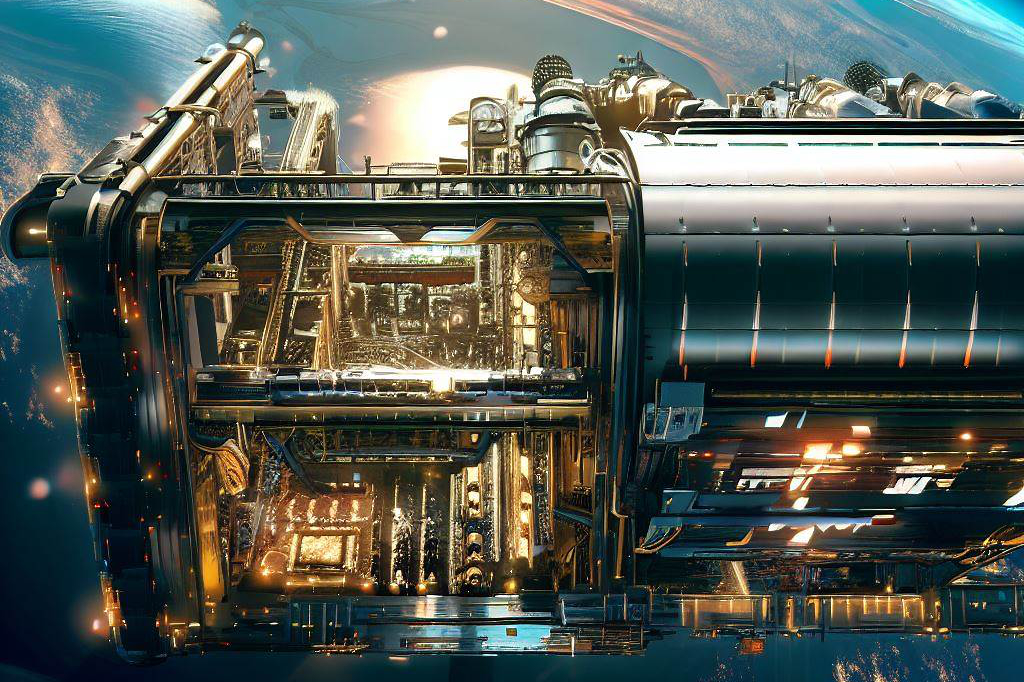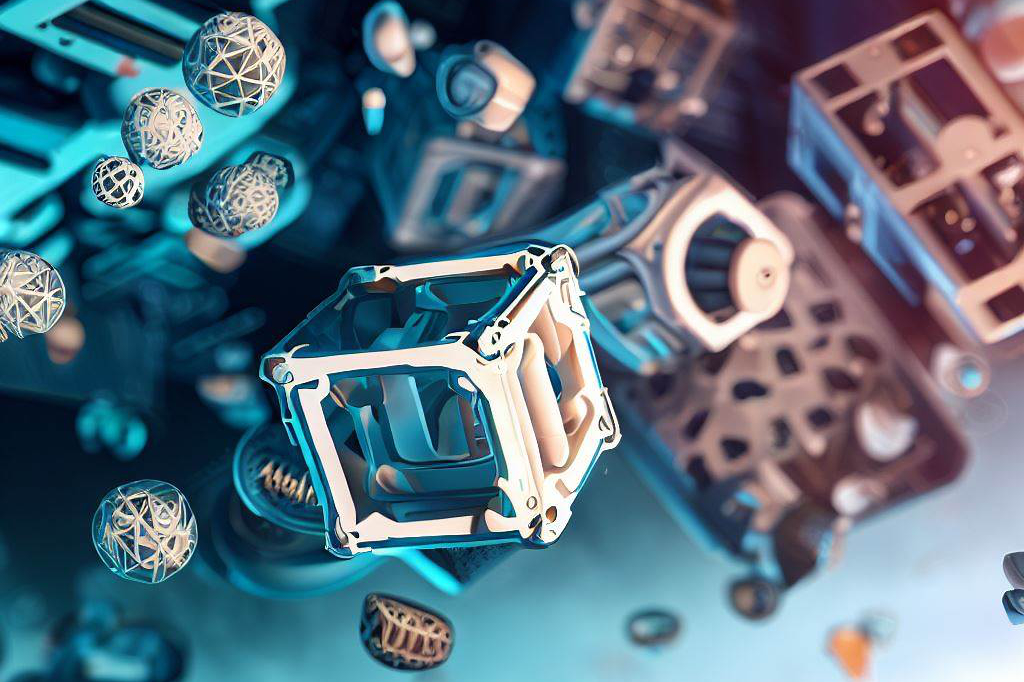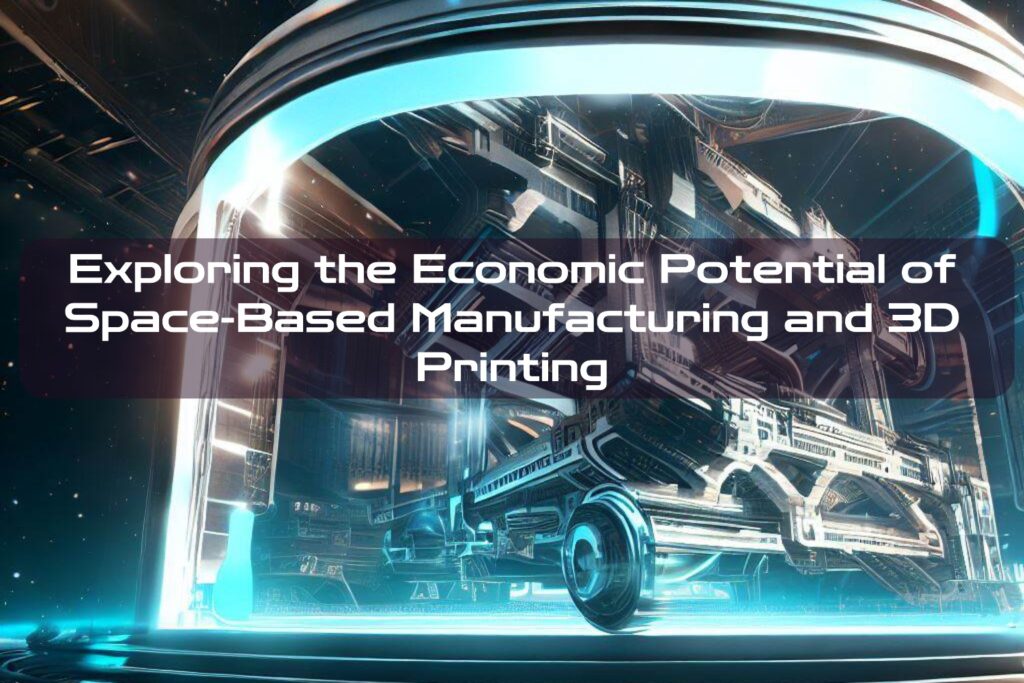A New Frontier for Business Ventures and Technological Achievements
The sky is no longer the limit when it comes to manufacturing and 3D printing. With space exploration becoming more prevalent, a new frontier has emerged for business ventures and technological achievements: space-based manufacturing.
Imagine being able to produce goods in a zero-gravity environment or using extraterrestrial resources that are otherwise scarce on Earth.
That’s the kind of potential that space-based manufacturing has, and it’s worth exploring.
Space-based manufacturing refers to the utilization of outer space as a site for production, assembly, or testing of products or services.
One of the most promising aspects of this technology is its use in 3D printing.
In recent years, we have seen tremendous growth in additive manufacturing technology on Earth, as it allows for efficient prototyping and faster production than traditional methods such as injection molding.
However, what if we could extend this technology into space? The possibilities are endless; we could see everything from medical implants to spacecraft components being produced with incredible efficiency.
The Importance of Exploring Economic Potentials

As our world continues to develop technologically, there is an increasing demand for innovation in business models and new ways to create value.
With growing populations and limited resources on Earth, it’s important that we explore alternative options to sustainably produce goods while minimizing waste. The economic potential of space-based manufacturing lies not only in its ability to produce goods more efficiently but also in its potential applications.
For example, producing high-quality materials with reduced weight could revolutionize the aerospace industry by reducing costs associated with launching payloads into orbit while also improving satellite performance. Additionally, utilizing 3D printing technology in space could lead to further advancements in areas such as medicine, where implants or prosthetics could be custom-made on-demand and with extreme precision.
Harnessing the potential of space-based manufacturing is not without its challenges, but it offers a unique opportunity for innovation and growth in the business world. As private companies and government agencies continue to invest in this field, we may see new markets emerge that could revolutionize industries as we know them.
Advantages of Space-Based Manufacturing

Zero gravity environments allow for unique manufacturing capabilities
One of the biggest advantages of space-based manufacturing is the unique environment it provides. The lack of gravity allows for new manufacturing capabilities that are impossible to achieve on Earth.
Objects can be printed layer by layer without gravity-induced deformities or inconsistencies. This makes it possible to create complex structures and intricate designs that would be difficult or even impossible to produce on Earth.
In addition, being in zero-gravity allows for the production of materials with different properties than what is possible on Earth. In particular, alloys and composites made in space can have improved mechanical properties, which makes them ideal for use in high-performance applications such as aerospace and robotics.
Reduced costs due to lack of atmospheric interference and transportation expenses
Another advantage of space-based manufacturing is the reduced costs associated with production. There is no atmospheric interference in space, which means that there are fewer impurities in raw materials and less wear-and-tear on machines during production. This results in higher quality end-products at a lower cost.
In addition, transportation expenses are reduced because products can be manufactured directly where they are needed – whether on a space station or a planet’s surface. This eliminates the need for expensive launches from Earth and reduces delivery times significantly.
Increased efficiency in production due to lack of gravity-induced deformities
Gravity has a significant impact on many aspects of manufacturing, including
- material flow,
- heat transfer,
- and fluid dynamics.
In zero-gravity environments, these factors are simplified, which leads to greater efficiency in production processes. For example, without gravity-induced deformities or inconsistencies during printing processes, 3D printers can produce parts faster with fewer defects than their earth-based counterparts.
This increased efficiency also means that more parts can be produced at once, resulting in faster turnaround times and higher overall productivity.
Space-based manufacturing has numerous advantages over traditional manufacturing methods thanks to the unique environment provided by zero-gravity.
The lack of atmospheric interference, transportation expenses, and gravity-induced deformities all contribute to a more efficient and lower cost production process. As technology continues to advance in this field, it’s exciting to think about the possibilities for new materials, products, and applications that can be achieved through space-based manufacturing.
Potential applications for space-based manufacturing and 3D printing

Production of high-quality, lightweight materials for aerospace industry
The ability to produce high-quality, lightweight materials in space has the potential to revolutionize the aerospace industry. With zero gravity and no atmospheric interference, manufacturers can create structures that are impossible to make on Earth.
For example, complex geometries can be created with ease, such as thin-walled structures with internal truss-like supports that are difficult or impossible to produce on Earth.
One of the most promising materials for space-based manufacturing is carbon fiber-reinforced polymer (CFRP) composites.
CFRP composites offer a unique combination of strength and weight savings that make them attractive for applications where weight is an issue. These materials can be used in spacecraft construction, reducing launch costs by saving weight.
Creation of medical supplies and equipment in space
Another application of space-based manufacturing is the creation of medical supplies and equipment. The lack of gravity in space makes it an ideal environment for producing certain types of medical devices, such as implants or prosthetics, that require a high degree of precision in their manufacturing process.
Additionally, the production of pharmaceuticals could also benefit from space-based manufacturing due to microgravity’s unique benefits. In microgravity environments like those found in low Earth orbit or on International Space Station (ISS), it is easier to produce pure crystals without impurities, making drugs more potent while at the same time reducing waste.
Development of new technologies such as solar panels or advanced electronics
Solar panels are one technology that could receive a boost from space-based manufacturing. Production methods using 3D printing technology have been developed that allow for intricate designs that maximize surface area exposure to sunlight, which translates into increased energy efficiency levels.
In addition to solar panels, developing advanced electronic components like semiconductors, LCD screens, or LED lights can also be a great application of space-based manufacturing. During the manufacturing process, gravity could cause issues like sedimentation, but with zero-gravity conditions in space, materials are evenly distributed throughout, making it easier to create flawless products.
Overall, the potential applications for space-based manufacturing and 3D printing are endless with the growth of new technologies and exploration into new industries. Space-based manufacturing has the potential to revolutionize how we create things by offering unique capabilities that can’t be found on Earth’s surface.
Challenges to Overcome

High Upfront Costs Associated with Launching Equipment into Space
One of the biggest challenges in space-based manufacturing is the high upfront cost associated with launching equipment and supplies into space. The current cost of sending just 1 kilogram of material into orbit is around $10,000. This means that even small projects can quickly become prohibitively expensive.
To overcome this challenge, companies and organizations are exploring new ways to reduce launch costs, such as reusable rockets or in-orbit refueling. Additionally, as technology continues to advance, it may become more affordable to manufacture equipment and materials directly in space rather than launching them from Earth.
Limited Availability of Resources Such as Raw Materials or Energy Sources
Another significant challenge is the limited availability of resources such as raw materials or energy sources in space. While some materials can be found on other planets or asteroids, it can be difficult and expensive to extract and transport them. To address this challenge, research is being conducted on ways to use available resources more efficiently.
For example, 3D printing technology could potentially allow for the creation of complex parts using a minimal amount of raw material by printing only what is needed. Additionally, there are efforts underway to develop new energy sources, such as solar power satellites, that could provide a reliable energy source for space-based manufacturing operations.
Need for Specialized Training and Expertise
Space-based manufacturing requires specialized training and expertise due to the unique environment and technological requirements. Workers must have knowledge about topics such as
- zero gravity physics,
- spacecraft design and operation,
- robotics programming,
- and advanced materials science.
To address this challenge, educational programs are being developed that focus specifically on space-based manufacturing and related fields. Additionally, government agencies such as NASA are partnering with private companies to provide training opportunities for employees working in this industry.
Overall, while there are significant challenges to overcome in space-based manufacturing and 3D printing, it is clear that the potential benefits are significant. By finding ways to overcome these obstacles, we may be able to unlock new capabilities and create a sustainable economic future for space exploration.
Future Outlook and Opportunities

Growing Interest from Private Companies and Government Agencies in Space-Based Manufacturing
The economic potential of space-based manufacturing has not gone unnoticed by private companies and government agencies alike. Several companies have already made significant investments in this field, including Made In Space, which created the first-ever 3D printer to operate in space.
NASA is also heavily invested in exploring the possibilities of space-based manufacturing, with plans to build a lunar base that could eventually serve as a hub for manufacturing operations. This growing interest is fueled by the unique opportunities that space-based manufacturing presents.
The zero-gravity environment allows for the production of materials that are impossible to manufacture on Earth. Additionally, reduced transportation costs and increased production efficiency make space-based manufacturing an attractive alternative to traditional methods.
Potential for Increased Collaboration between Industries, Universities, and Research Institutions
As interest in space-based manufacturing grows, so does the potential for collaboration between industries, universities, and research institutions. The development of new technologies requires expertise from a range of fields, including engineering, materials science, and additive manufacturing.
Collaboration can lead to faster innovation as well as increased funding opportunities. For example, NASA’s Small Business Innovation Research (SBIR) program provides funding opportunities for small businesses interested in developing technology related to NASA’s mission goals.
Possibility for New Markets to Emerge as Technology Advances
As technology advances in the fields of space-based manufacturing and 3D printing, there is potential for new markets to emerge.
For example, the production of high-quality lightweight materials could lead to advancements in areas such as transportation or construction.
Additionally, medical supplies produced in space could help address shortages here on Earth. As private companies continue to invest heavily in research and development within this field, it’s possible that entirely new industries could emerge over time.
The possibilities of space-based manufacturing are only just beginning to be explored, and the economic potential is vast. As technology continues to advance, it will be exciting to see what new opportunities arise.
Final Thoughts: Unlocking the Economic Potential of Space-Based Manufacturing and 3D Printing
Space-based manufacturing and 3D printing hold immense economic potential for a variety of industries, ranging from aerospace engineering to medical supply production.
By leveraging the unique capabilities offered by the zero-gravity environment, researchers and industry experts alike can produce high-quality materials, innovative technologies, and equipment that are either too costly or impossible to manufacture on Earth.
The benefits of space-based manufacturing are numerous, including reduced costs associated with transportation, increased efficiency in production, and the ability to create advanced materials with specific properties that cannot be replicated on Earth.
The potential applications for space-based manufacturing are vast – from creating lightweight yet strong components for spacecraft to producing vital medical supplies in outer space to developing new energy technologies through solar panel fabrication.
While there are still challenges that must be overcome before widespread adoption of space-based manufacturing can become a reality – such as the high initial investment costs necessary to launch equipment into space or limited availability of resources – there is a growing interest among private companies, academic institutions, and government organizations in exploring this field further.
As technology continues to advance, it is not hard to imagine a future where space-based manufacturing becomes a commonplace practice across many different industries.
While we have only scratched the surface of what is possible with regard to space-based manufacturing and 3D printing thus far, the potential economic benefits are incredibly promising. With continued investment in research and development coupled with increasing public-private partnerships between entrepreneurs and government agencies alike, we may see an economic renaissance in outer space not seen since man first set foot on the moon nearly half a century ago.

C M, a seasoned editor, journalist, and consultant, is deeply fascinated by the convergence of technology, space, and the future of humanity.
With a particular interest in transhumanity, futurology, and the philosophical and ethical dimensions of these domains, C M serves as the lead contributor to SpaceSpotlight and TranscendSphere.
When not penning insightful articles on these rapidly evolving fields, C M indulges in their love for podcasts and books, proudly embracing their status as a ‘Happy Nerd Extraordinaire!’
